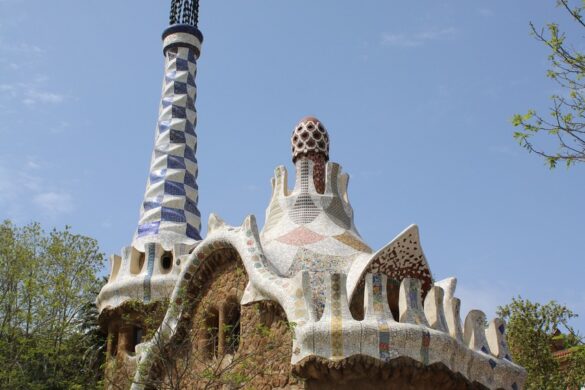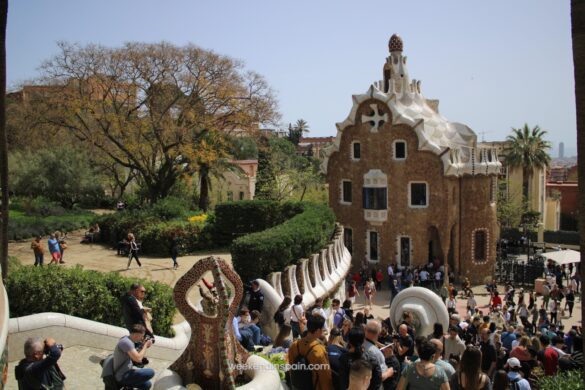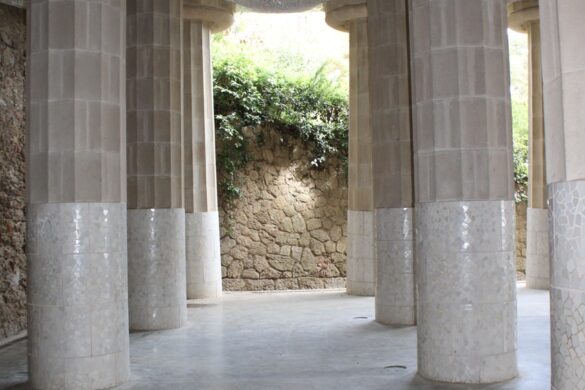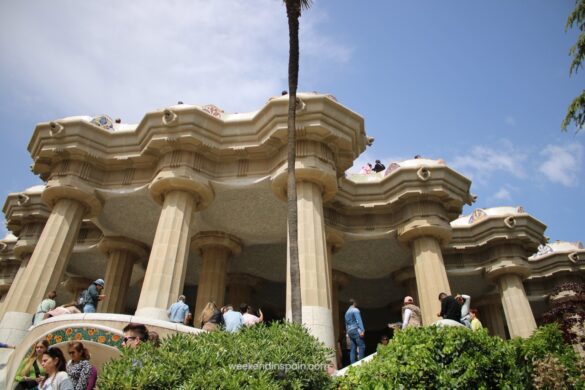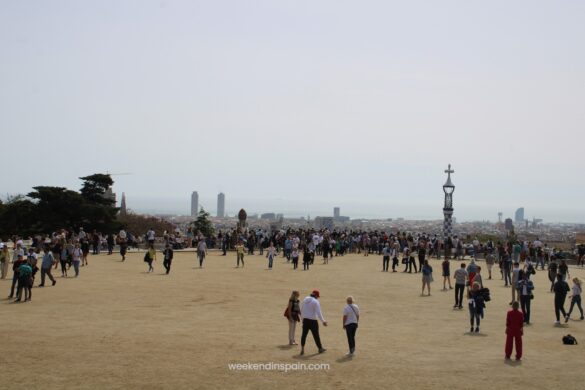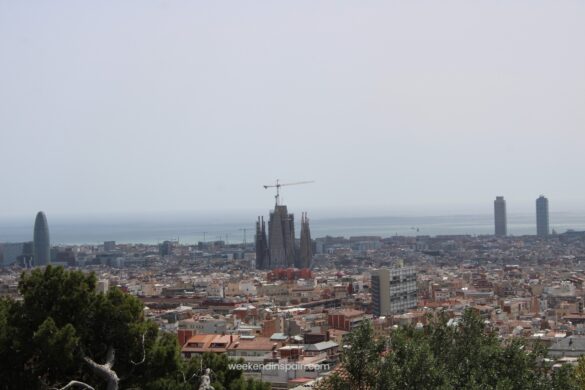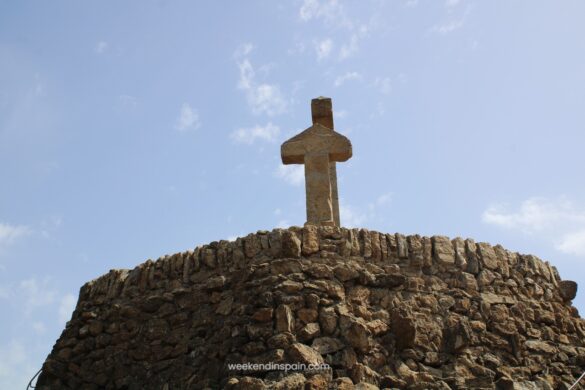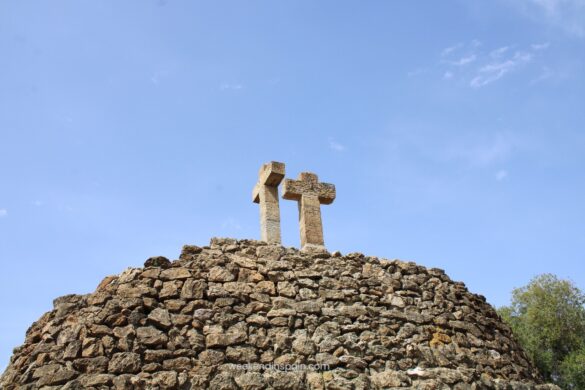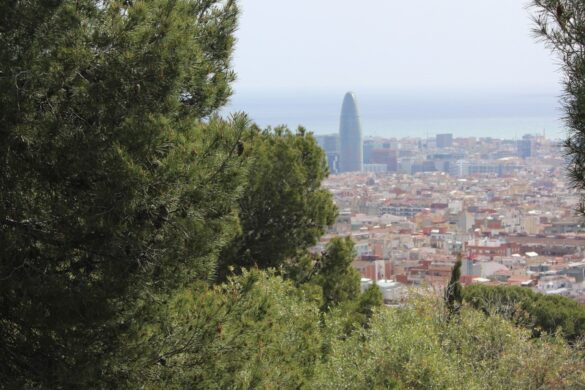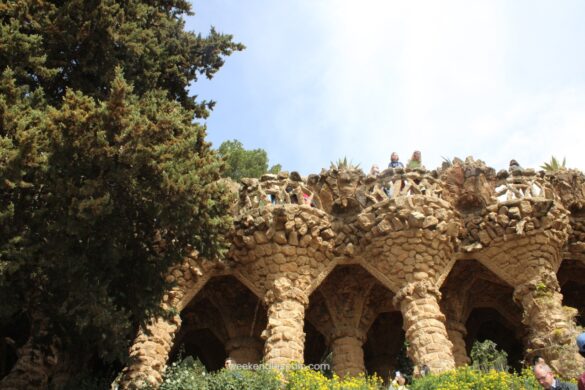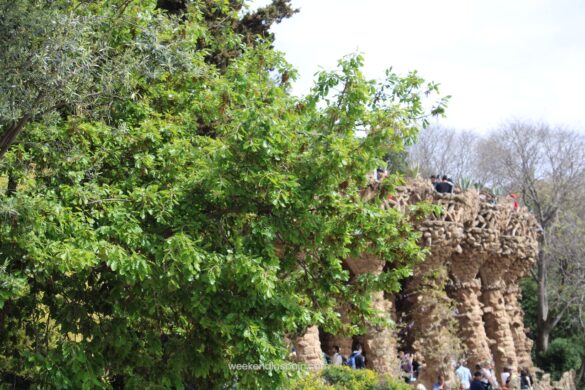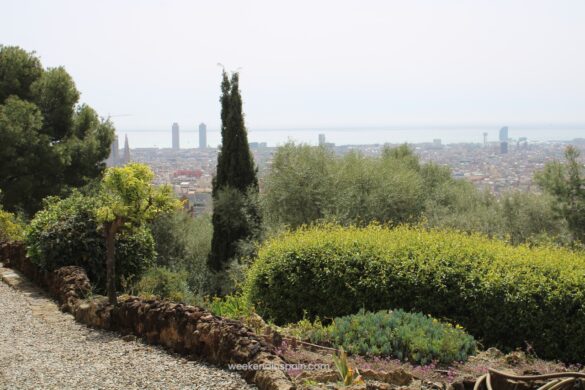
Park Güell is one of my favourite parks in Barcelona. In this blog post, I’m going to share some of my tips that I hope you will find useful when visiting this masterpiece.
Table of Contents
PARK GÜELL | INFO, REVIEW & TIPS
Parl Güell measures at 17 hectares and overlooks Barcelona from above, Park Güell is one of the best examples of Catalan Modernism architecture and was designed by none other than Antoni Gaudí, the renowned Catalan architect.
Gaudí had his own unique style of designing and building all kinds of buildings that merged architecture with recycled materials, wrought-iron, and most importantly, Trencadís that you will see many buildings and other elements clad with in this park, as you might have or will also see in other extraordinarily beautiful buildings built by him. Trencadís is the name given to a typical type of tiled mosaic, the colour of which varies, giving it the effect of nature, which Gaudí was quite fond of.
HISTORY
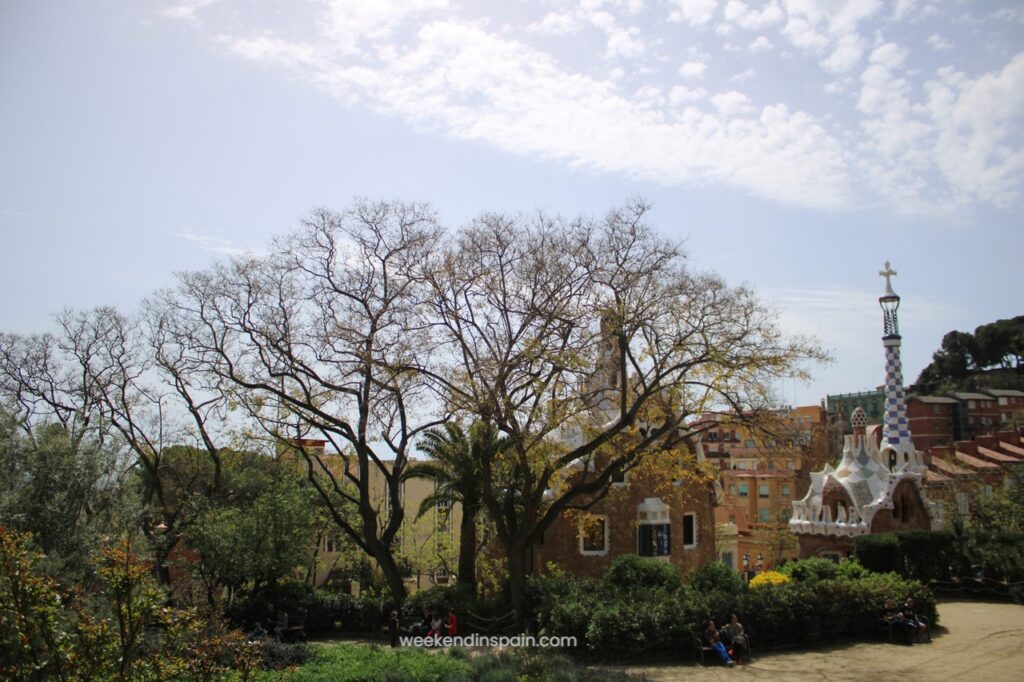
Park Güell dates back to 1900, when a wealthy businessman called Eusebi Güell, who had already commissioned Gaudí for other projects, offered him an even bigger project this time around; a luxury residential complex that would be like a huge green space in British style, which he would name after himself, Park Güell.
The project started in the same year, though in just a few years’ time, the construction faced difficulties since the building plots were not only costly, but they were also far away from the city, with poor transport communication. Out of the 16 residential plots, only two were built; one of them was commissioned by a friend of Güell, while the other was the one in which Gaudí himself lived, along with his family. Unfortunately, the project was completely halted due to the outbreak of the First World War in 1914.
After the death of Eusebi Güell in 1918, the Barcelona city council decided to buy the estate, turning it into a public park and opening it in 1926. The park has since become one of Barcelona’s main tourist attractions.
Park Güell was also recognised by the Spanish state in 1969, when it was declared a Monument of Cultural Interest, and in 1984, it was declared a World Heritage Site by UNESCO.
WHAT TO SEE AT PARK GÜELL
Interestingly, Park Güell has a lot to offer. Here are some of the things that you’ll see in the park, apart from the fantastic views of Barcelona.
PORTER’S LODGE PAVILIONS/CASA DEL GUARDA
The very first architectural beauty that you see are the two trencadís-clad porter’s lodge (la casa del guarda) pavilions on either side of the main entrance gate, which look like the ones you see in fairy tale films and instantly give you the feeling as if you’re looking at a house made out of gingerbread. The stunningly beautiful buildings are visible from any part of the park. The top-most part of both is like a reddish dome in the shape of a mushroom – both are now used for tours and a gift shop.
In my opinion, the lodges are more impressive from the outside, especially the uneven roofs coated with matching tiles and colours to create the perfect contrast.
THE DRAGON STAIRWAY
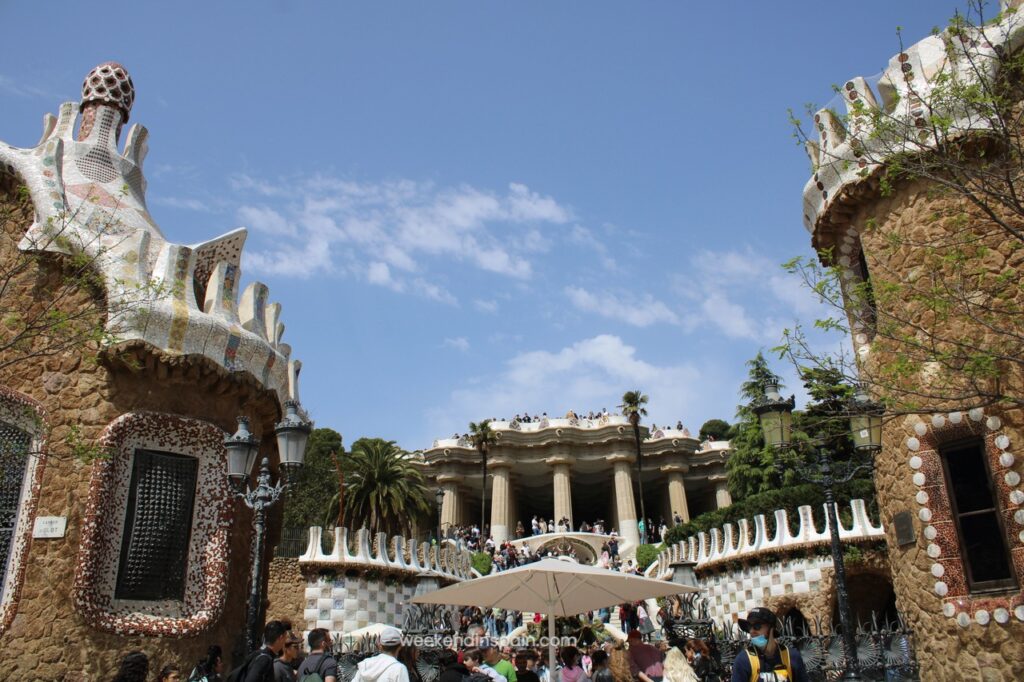
As soon as you enter the park, you’ll see a dragon-like stairway with a salamander sculpture, beautifully coated in colourful mosaic, right in the middle. The stairway is divided into two parts with fountains between them. Unfortunately, I couldn’t get a shot of the sculpture as there was a big parasol at the entrance blocking the view from where I was, but maybe I should’ve tried from a different angle—I didn’t realise it then.
SALA HISPÓSTALIA/THE HYPOSTYLE ROOM
Hypostyle Hall, also known as the Hall of Columns, is a Greek-style porch with an uneven roof, located up the stairways. It serves as a support for the central square above, and has 86 columns in Doric architectural design, where the exterior ones are slightly inclined. The lower part of the columns is coated with white-colour mosaic. The Hall was built between 1907 and 1909, with the aim of creating a market for the housing development, but due to the aforementioned project failure, it was neither built properly nor inaugurated. The hall now just serves as part of the architectural beauty that the park has to offer, where you get to enjoy seeing the curiously shaped columns and trencadís, and where you will also get to see musicians entertaining visitors.
There are four colourful mosaic rosettes on the hall ceiling, each one representing one of the four seasons of the year.
PLAÇA DE LA NATURA
Placa de la Natura is located on the roof of Sala Hipóstila, a huge, oval-shaped square that Gaudí designed as a Greek theatre for spectacles, as well as for community gatherings. The square is the central part of the park. Built between 1907 and 1913, it provides a beautiful aerial view of Barcelona, is supported by the columns of Sala Hipóstila.
Gaudí’s initial plan was to build a Greek theatre for the residential complex, a space for shows that would be visible from every corner of the premises surrounding it.
The square has an undulating, serpentine bench covered with pieces of mosaic, in the form of trencadís, and designed and made by Gaudí’s favourite collaborator, Josep Maria Jujol, a renowned architect as well, but who was somewhat overlooked due to the presence of Gaudí.
Just a few years ago, there was some restoration work done on both the Hypostyle Hall and the square: waterproofing the roof of the hall and constructing an efficient drainage system, so that rainwater wouldn’t cause any inconvenience to visitors, or cause damage to the park. Apart from this, the bench in the square above was also restored.
TURÓ DE LES TRES CREUS/HILL OF THE THREE CROSSES
Turó de les tres creus, also known as Monumento al Calvario, is a monument with three crosses, located at the highest part of the park, where there is a small stone hill that leads to a viewpoint from which you have beautiful panoramic views of Barcelona.
This is where Gaudí had initially planned to build a chapel, but when the project failed, he designed and crowned the monument in the form of a calvary, with three crosses, one of which is shaped like an arrow and points at the sky.
THE AUSTRIA GARDENS
There are two particular spots at Park Güell that offer the best views of the city of Barcelona, one is the El Calvario monument, which is located at the highest part of the park, and the other is this spot, known as Jardines de Austria. It was in 1977 when these beautiful trees were donated by Austria, that’s how the garden got its name.
The Austria Gardens are on the left side when you walk up the iconic staircase and are surprisingly not as busy as other spots in the park. The organic stone columns are something to look at, as you rarely get to see them anywhere else.
CASA MARTÍ TRIAS I DOMÈNECH
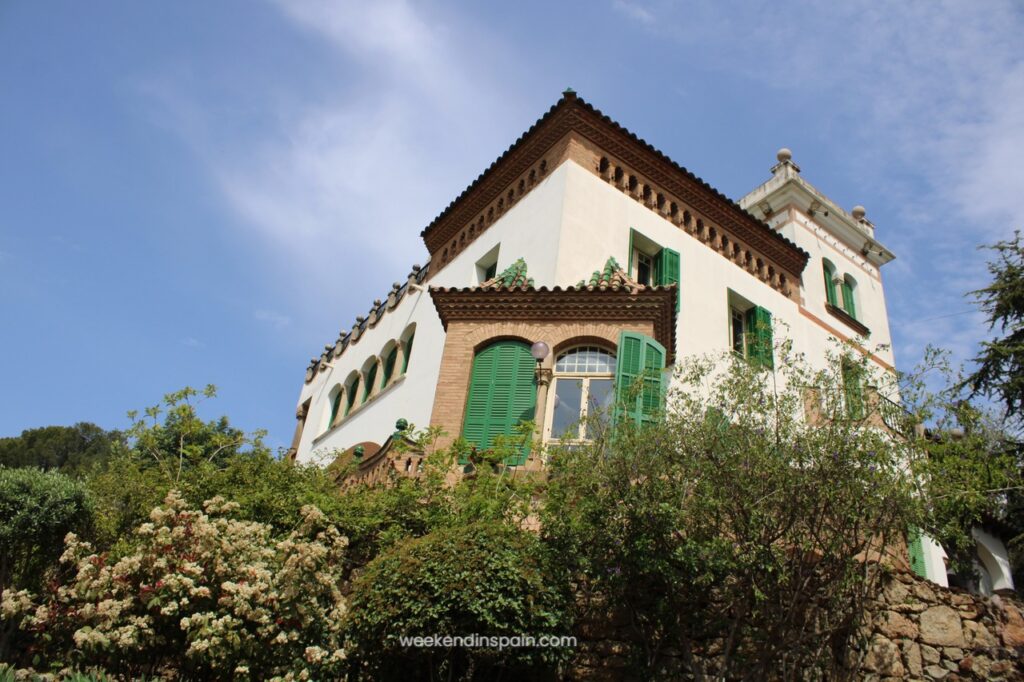
This modernist house of the lawyer Martí Trias i Domènech and his family was designed and built in 1905 by an architect called Juli Batllevell. The beautiful white house with green windows can be seen from the centre of Austria Gardens.
GAUDÍ’S HOUSE
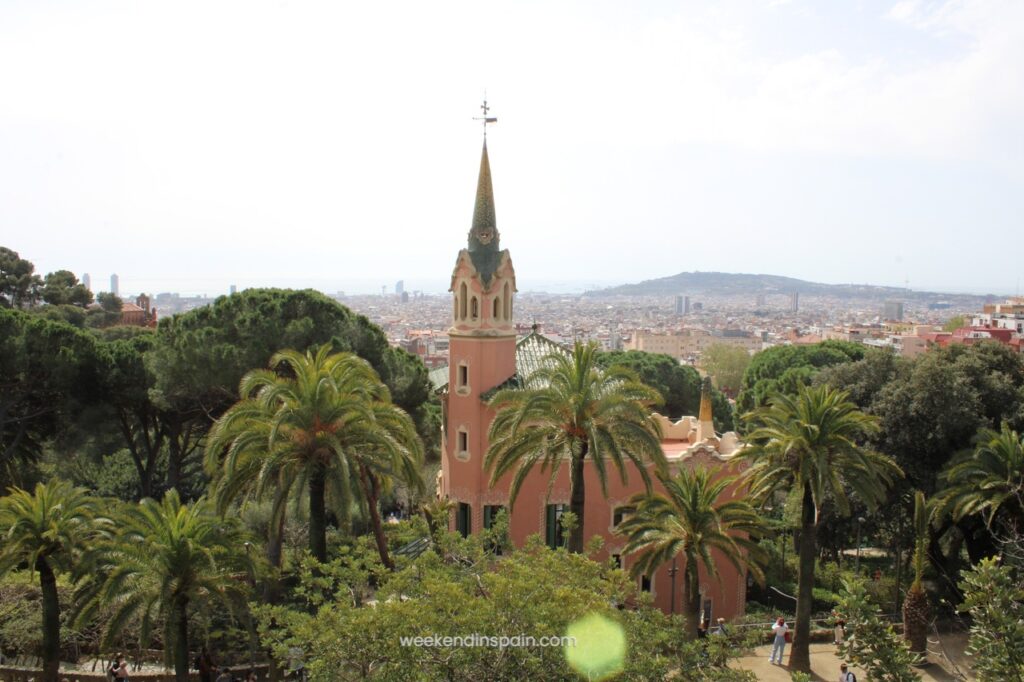
This museum actually used to be Antoni Gaudí’s house, where he lived between 1906 and 1925, until his untimely death. The stunningly beautiful Modernist mansion, designed by Gaudí’s collaborator Francesc Berenguer, allows visitors to learn about Gaudí’s private life, as they tour his bedroom and studio. There are several objects and household furniture designed by Gaudí himself.
HOW MUCH TIME TO SPEND IN PARK GÜELL
Although you can see the park takes an hour or so, I would recommend at least an hour and a half, or a max of two hours. I don’t think you’d want to stay for more than 2 hours if you have other places to check out, but like I said, an hour and a half, or just a tad more should be enough.
HOW TO GET TO PARK GÜELL
There are loads of options to get to Park Güell. However, in our case, we took bus no. H6 from Mitre – Balmes and got off at Trav de Dalt – Torrent de les Flors, and from there we walked all the way up to Park Güell. I think it took us about 10 or 12 minutes to get to the park.
The most common transport that many tourists opt to take is bus number 24, which leaves from the main tourist spots in Barcelona. Here’s a link to the bus route:
https://www.tmb.cat/es/barcelona/autobuses/-/lineabus/24
And if you’re going to Park Güell from La Sagrada Familia, you can take the L5 (if you have enough time, you could even walk all the way to Verdaguer metro station – the walk from La Sagrada Familia is about 15 min), which is the blue line, change at Verdaguer to the L4, the yellow one, and get off at Alfons X. You could also take a bus and get off at Joanic, but I strongly recommend taking the metro instead because buses can sometimes be either late or can get overcrowded. The walk from Alfons X should not take more than 15 minutes.
If you’re going to the park from any other location, you can always check out the TMB website, the link for which has already been provided above. Also, the staff at underground stations can guide you, and most of them speak English, so it shouldn’t be a problem.
PARK GÜELL TICKETS AND TOURS
Here’s a link to the official website of Park Güell, where you can directly purchase your tickets. The same website has lots of other information, like how to get to Park Güell by different means of transport, although in the very previous section of this blog post, I’ve already mentioned how we went to the park.
https://www.parkguell-tickets.com/
IS PARK GÜELL WORTH IT?
First of all, it all depends on what you intend to see during the whole day in Barcelona, and, most importantly, where you’re staying. If you’re right in the middle of the city centre, you might as well check out La Pedrera or Casa Battló first, but if you’re staying around Gràcia or Lesseps, you could opt for Park Güell first, instead.
Another important tip is to visit the park early in the morning if you can, but if you can’t, don’t worry, evening time is good too. I’ve visited the park in the morning as well as in the evening, and I enjoyed both of my visits.
I’ve written blog posts on other Gaudí masterpieces that you could visit, and I highly recommend visiting these beautiful monuments:
La Sagrada Familia
Casa Battló
La Pedrera
Thank you for reading this blog post. I hope you have a fantastic time in Barcelona.
